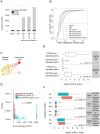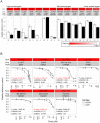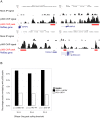Linking proteomic and transcriptional data through the interactome and epigenome reveals a map of oncogene-induced signaling
- PMID: 23408876
- PMCID: PMC3567149
- DOI: 10.1371/journal.pcbi.1002887
Linking proteomic and transcriptional data through the interactome and epigenome reveals a map of oncogene-induced signaling
Abstract
Cellular signal transduction generally involves cascades of post-translational protein modifications that rapidly catalyze changes in protein-DNA interactions and gene expression. High-throughput measurements are improving our ability to study each of these stages individually, but do not capture the connections between them. Here we present an approach for building a network of physical links among these data that can be used to prioritize targets for pharmacological intervention. Our method recovers the critical missing links between proteomic and transcriptional data by relating changes in chromatin accessibility to changes in expression and then uses these links to connect proteomic and transcriptome data. We applied our approach to integrate epigenomic, phosphoproteomic and transcriptome changes induced by the variant III mutation of the epidermal growth factor receptor (EGFRvIII) in a cell line model of glioblastoma multiforme (GBM). To test the relevance of the network, we used small molecules to target highly connected nodes implicated by the network model that were not detected by the experimental data in isolation and we found that a large fraction of these agents alter cell viability. Among these are two compounds, ICG-001, targeting CREB binding protein (CREBBP), and PKF118-310, targeting β-catenin (CTNNB1), which have not been tested previously for effectiveness against GBM. At the level of transcriptional regulation, we used chromatin immunoprecipitation sequencing (ChIP-Seq) to experimentally determine the genome-wide binding locations of p300, a transcriptional co-regulator highly connected in the network. Analysis of p300 target genes suggested its role in tumorigenesis. We propose that this general method, in which experimental measurements are used as constraints for building regulatory networks from the interactome while taking into account noise and missing data, should be applicable to a wide range of high-throughput datasets.
Conflict of interest statement
The authors have declared that no competing interests exist.
Figures





Similar articles
-
Integration of RNA-Seq and proteomics data identifies glioblastoma multiforme surfaceome signature.BMC Cancer. 2021 Jul 23;21(1):850. doi: 10.1186/s12885-021-08591-0. BMC Cancer. 2021. PMID: 34301218 Free PMC article.
-
Bioinformatics analyses of significant genes, related pathways and candidate prognostic biomarkers in glioblastoma.Mol Med Rep. 2018 Nov;18(5):4185-4196. doi: 10.3892/mmr.2018.9411. Epub 2018 Aug 21. Mol Med Rep. 2018. PMID: 30132538 Free PMC article.
-
Transcriptomic and Proteomic Data Integration and Two-Dimensional Molecular Maps with Regulatory and Functional Linkages: Application to Cell Proliferation and Invasion Networks in Glioblastoma.J Proteome Res. 2015 Dec 4;14(12):5017-27. doi: 10.1021/acs.jproteome.5b00765. Epub 2015 Oct 23. J Proteome Res. 2015. PMID: 26464075
-
Comparative analysis of protein interactome networks prioritizes candidate genes with cancer signatures.Oncotarget. 2016 Nov 29;7(48):78841-78849. doi: 10.18632/oncotarget.12879. Oncotarget. 2016. PMID: 27791983 Free PMC article.
-
Integrated analyses to reconstruct microRNA-mediated regulatory networks in mouse liver using high-throughput profiling.BMC Genomics. 2015;16 Suppl 2(Suppl 2):S12. doi: 10.1186/1471-2164-16-S2-S12. Epub 2015 Jan 21. BMC Genomics. 2015. PMID: 25707768 Free PMC article.
Cited by
-
Towards structural systems pharmacology to study complex diseases and personalized medicine.PLoS Comput Biol. 2014 May 15;10(5):e1003554. doi: 10.1371/journal.pcbi.1003554. eCollection 2014 May. PLoS Comput Biol. 2014. PMID: 24830652 Free PMC article. Review.
-
Circulating biomarkers for gliomas.Nat Rev Neurol. 2015 Oct;11(10):556-66. doi: 10.1038/nrneurol.2015.171. Epub 2015 Sep 15. Nat Rev Neurol. 2015. PMID: 26369507 Review.
-
Integrative Multi-Omics Approaches in Cancer Research: From Biological Networks to Clinical Subtypes.Mol Cells. 2021 Jul 31;44(7):433-443. doi: 10.14348/molcells.2021.0042. Mol Cells. 2021. PMID: 34238766 Free PMC article. Review.
-
Integrated systems biology analysis of KSHV latent infection reveals viral induction and reliance on peroxisome mediated lipid metabolism.PLoS Pathog. 2017 Mar 3;13(3):e1006256. doi: 10.1371/journal.ppat.1006256. eCollection 2017 Mar. PLoS Pathog. 2017. PMID: 28257516 Free PMC article.
-
Impacts of cannabinoid epigenetics on human development: reflections on Murphy et. al. 'cannabinoid exposure and altered DNA methylation in rat and human sperm' epigenetics 2018; 13: 1208-1221.Epigenetics. 2019 Nov;14(11):1041-1056. doi: 10.1080/15592294.2019.1633868. Epub 2019 Jul 11. Epigenetics. 2019. PMID: 31293213 Free PMC article. Review.
References
-
- Gil JM, Rego AC (2008) Mechanisms of neurodegeneration in Huntington's disease. Eur J Neurosci 27: 2803–2820 Available:http://dx.doi.org/10.1111/j.1460-9568.2008.06310.x. - DOI - PubMed
-
- Imarisio S, Carmichael J, Korolchuk V, Chen C-W, Saiki S, et al. (2008) Huntington's disease: from pathology and genetics to potential therapies. Biochem J 412: 191–209 Available:http://dx.doi.org/10.1042/BJ20071619. - DOI - PubMed
-
- Schinner S, Scherbaum WA, Bornstein SR, Barthel A (2005) Molecular mechanisms of insulin resistance. Diabet Med 22: 674–682 Available:http://dx.doi.org/10.1111/j.1464-5491.2005.01566.x. - DOI - PubMed
-
- Hanahan D, Weinberg RA (2011) Hallmarks of cancer: the next generation. Cell 144: 646–674 Available:http://dx.doi.org/10.1016/j.cell.2011.02.013. - DOI - PubMed
-
- Hanahan D, Weinberg RA (2000) The hallmarks of cancer. Cell 100: 57–70. - PubMed
Publication types
MeSH terms
Grants and funding
LinkOut - more resources
Full Text Sources
Other Literature Sources
Molecular Biology Databases
Research Materials
Miscellaneous

